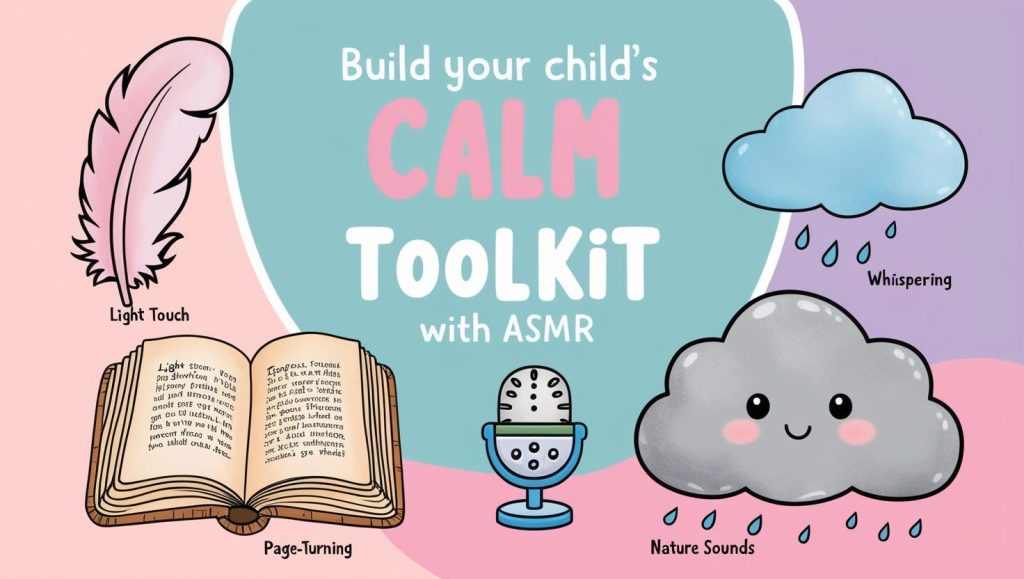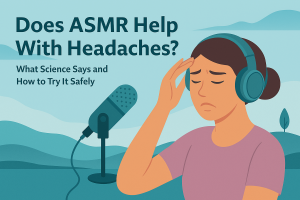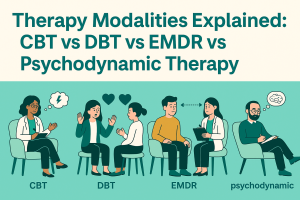What is ASMR and Why is it Trending Among Kids?
If your child has ever asked to watch someone whispering softly into a microphone or tapping their fingers on a piece of plastic, chances are they’ve stumbled into the world of ASMR. It stands for Autonomous Sensory Meridian Response, and while it might sound like science fiction, it’s actually a sensory experience that’s become incredibly popular—especially with kids and teens.
ASMR videos feature soothing sounds or visuals designed to relax the mind and body. Think of the gentle sound of someone turning book pages, brushing hair, or speaking in a calm whisper. Millions of people—adults and children alike—use ASMR videos to help them unwind, focus, or fall asleep. With platforms like YouTube and TikTok making these videos more accessible than ever, children are discovering ASMR at younger ages and incorporating it into their daily routines.
So, as a parent, you’re probably asking: “Is ASMR safe for my child?” And more importantly—should they be watching it at all?
The Growing Popularity of ASMR Content on YouTube and TikTok
Over the last few years, ASMR has exploded in popularity. YouTube is home to thousands of ASMR creators, many of whom have millions of subscribers. TikTok, with its fast, engaging format, has brought ASMR to an even younger audience. On both platforms, ASMR videos range from simple sound experiments to elaborate roleplays involving themes like sleep clinics, schools, or fantasy characters.
And kids aren’t just watching—they’re participating. Many children enjoy creating their own ASMR videos, recording themselves whispering or playing with textured objects. It’s a creative outlet, a stress reliever, and sometimes, a bonding activity between siblings or friends.
But with great popularity comes great responsibility. The internet can be a mixed bag, and not all ASMR content is created equal. That’s why it’s important to dive deeper into what ASMR really is, how it affects children, and how you as a parent can help ensure a safe and positive experience.

Understanding ASMR
The Science Behind ASMR
ASMR is described as a tingling, relaxing feeling that often starts in the scalp and moves down the back of the neck and spine. It’s triggered by specific sounds or visuals—like whispering, tapping, brushing, or soft-spoken instructions. Although not everyone experiences the physical tingles, most people still find ASMR soothing and calming.
Neurologically, ASMR activates areas of the brain related to emotional arousal, social bonding, and relaxation. It’s known to reduce heart rate, calm the nervous system, and even promote the release of “feel-good” chemicals like dopamine and oxytocin. In other words—it works like a natural anti-anxiety treatment without any side effects.
For kids who deal with stress, overstimulation, or trouble sleeping, ASMR can be a gentle, comforting tool. But that doesn’t mean every video on the internet is suitable for younger audiences. Understanding the type of content and how it’s delivered is crucial for safety.
Common Triggers and Why They Work
Some of the most common ASMR triggers include:
- Whispering or soft speaking
- Tapping on objects (wood, plastic, glass)
- Page turning and paper crinkling
- Brushing or hair sounds
- Nature sounds like rain, thunder, or ocean waves
- Roleplay scenarios (doctor, teacher, bedtime)
These sounds often mimic nurturing, safe, or familiar interactions. For children, this could resemble bedtime routines, calming parent talk, or school sounds. The repetition and softness of these triggers help quiet the brain and body, making it easier to rest or focus.
Some kids are especially sensitive to auditory or visual stimulation, and ASMR can act as a gentle sensory “massage” that brings them back to a calm state. It’s part neuroscience, part emotional care—and that’s why it appeals so strongly to kids who may not yet have other coping tools.
Why Kids Are Drawn to ASMR
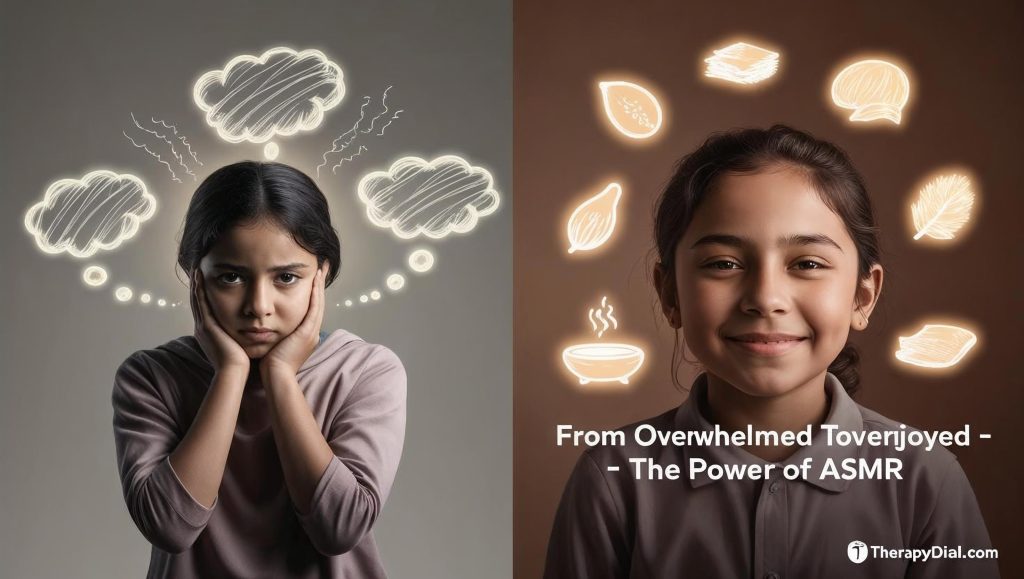
Emotional Regulation and Comfort
Children are naturally drawn to environments and experiences that make them feel safe. With school stress, peer pressure, and even family dynamics playing a role in childhood anxiety, ASMR becomes an unexpected source of emotional regulation.
It’s not just about tingles—it’s about the comfort these videos provide. A soft-spoken voice offering encouragement can feel like a warm hug. Tapping sounds create a rhythm that helps the mind settle, especially for kids with racing thoughts or trouble focusing. For many children, ASMR becomes their private safe space, one they can access any time with a pair of headphones and a phone or tablet.
Some children even use ASMR as a transitional tool between high-stress moments and rest. For example, after a difficult day at school, five minutes of ASMR before dinner can help reset their mood and reduce meltdowns.
Sensory Appeal and Calming Effect
In an overstimulating digital world filled with bright screens, loud games, and nonstop scrolling, ASMR offers the opposite—slow, soft, intentional sensory input. Kids with sensory sensitivities, ADHD, or high levels of emotional reactivity may find ASMR especially soothing because it delivers structured, gentle stimulation instead of chaos.
In fact, many parents notice their children instinctively seeking out calming content like nature sounds or slow-speaking videos even before they know what ASMR is. That’s because these kids are trying to regulate their nervous systems the only way they know how—through sensory comfort.
ASMR’s rise in popularity with children isn’t just a trend—it’s a testament to how powerful and universal our need for calm really is.
Is ASMR Content Safe for Children?
Evaluating the Type of Content
Here’s where things get tricky. While ASMR is generally safe, not all content on YouTube or TikTok is appropriate for kids. Some ASMR creators include roleplays or themes that might be confusing, overly mature, or even unintentionally inappropriate for younger audiences. Think nurse roleplays with adult tones, or content that uses whispering in a way that feels overly intimate.
Parents should treat ASMR like any other form of media—supervise, preview, and talk about it. Ask your child what they’re watching, who their favorite creators are, and what makes those videos appealing to them. You might be surprised at how honest and enthusiastic they are about it.
Look for channels that are transparent about being child-friendly. Many ASMRtists label their content specifically for young viewers and avoid suggestive language or themes altogether.
Differences Between Kid-Friendly ASMR and Adult-Oriented Content
Kid-friendly ASMR tends to include:
- Gentle sounds like tapping, brushing, and rain
- Positive affirmations geared toward children
- Fun, lighthearted themes like bedtime stories or drawing sessions
- Playful visuals like slime squishing or kinetic sand
Adult-oriented ASMR might include:
- Romantic or flirty tones
- Complex roleplays (therapists, doctors, “date night”)
- Darker themes or heavy whispering that can feel intense
- Inappropriate language or innuendo (even if subtle)
Always preview content before adding it to your child’s playlist. And when in doubt—watch it together.
Potential Benefits of ASMR for Children
Helps with Sleep and Relaxation
One of the most common reasons children turn to ASMR is to help them fall asleep. Whether it’s the soft whisper of a bedtime story, the rhythmic tapping of a pencil, or the gentle rustling of paper, ASMR content acts like a modern lullaby. For kids who have trouble winding down at night—whether due to anxiety, overstimulation, or just an active imagination—ASMR can bridge the gap between wakefulness and rest.
Sleep issues are common in children. According to pediatric studies, over 30% of school-aged kids experience sleep difficulties at least once a week. Introducing ASMR as part of a bedtime routine—alongside story time, soft lighting, and screen limitations—can dramatically improve relaxation and help kids transition into restful sleep more smoothly.
Parents have reported that children who once tossed and turned for hours now fall asleep within 15–30 minutes after watching or listening to calming ASMR. It’s like creating a digital cocoon—a space where nothing is demanded of them, and they can just “be.”
May Support Emotional and Behavioral Regulation
Beyond bedtime, ASMR can play a role in helping kids regulate their emotions throughout the day. Children often struggle to understand or express big feelings like anger, sadness, fear, or embarrassment. ASMR’s sensory stimulation has a soothing effect on the nervous system, which can aid in emotional self-regulation.
Some therapists have even started recommending ASMR content as part of emotional support strategies for kids who experience:
- Sensory processing challenges
- Autism spectrum behaviors
- Generalized anxiety
- ADHD-related overstimulation
When used in moderation, ASMR can serve as a healthy coping mechanism. It’s non-verbal, non-invasive, and entirely self-paced—giving children a sense of control over their internal world.
Parental Concerns and Misconceptions
Is ASMR Overstimulating or Addictive?
Let’s address a common parental worry: “Will my child get addicted to ASMR?” The short answer is—unlikely, especially when used in moderation and with appropriate content.
ASMR is designed to calm the brain, not stimulate it like video games or social media apps. It doesn’t trigger dopamine spikes in the same way that fast-paced, flashy content does. Instead, it promotes a parasympathetic response—the “rest and digest” mode that helps the body relax.
That said, any media, no matter how calming, should be part of a balanced routine. If your child is using ASMR for hours on end, avoiding interactions, or becoming upset when it’s taken away, that may be a sign of overdependence—not on ASMR itself, but on screen time as a whole.
Set clear expectations: limit viewing to specific times (e.g., before bed), choose only pre-approved channels, and encourage offline relaxation techniques as well.
Is It Linked to Any Mental Health Risks?
As of 2025, there’s no scientific evidence suggesting that ASMR poses any inherent risk to children’s mental health. On the contrary, studies have shown that ASMR can reduce anxiety, improve sleep, and enhance emotional well-being.
However, issues can arise from:
- Inappropriate content exposure
- Misuse of ASMR to avoid emotional engagement
- Overreliance on screens for comfort
That’s why parental involvement is so important. It’s not about banning ASMR, but about helping kids use it wisely and discussing why it makes them feel good. This builds awareness and creates opportunities for emotional education.
How to Monitor ASMR Use in Children
Guidelines for Screen Time and Exposure
The American Academy of Pediatrics recommends no more than 1 to 2 hours of screen time per day for school-aged children, not including homework. ASMR should fit within that limit, not stretch it.
Here are some practical guidelines:
- Use ASMR only during calming times, like bedtime or quiet hour
- Avoid using ASMR as a distraction tool during meals, conversations, or chores
- Keep volume low and encourage listening without headphones if possible
- Use timers or playlists that end after 20–30 minutes to prevent prolonged exposure
Make ASMR part of a holistic routine that includes offline calming tools like books, music, drawing, or even just lying quietly with a parent or pet.
Red Flags Parents Should Watch For
ASMR is generally positive—but if your child is:
- Obsessed with ASMR to the exclusion of other activities
- Withdrawing socially
- Reacting strongly if denied access
- Repeating adult-oriented phrases or behaviors seen in ASMR videos
- Seeking out content that isn’t age-appropriate
…then it’s time to step in and reassess their usage. Set healthy boundaries, talk openly about content, and possibly consult with a therapist if you’re concerned about emotional reliance.
Best Practices for Parents
Choosing Age-Appropriate Channels and Creators
Not all ASMR creators are kid-friendly, even if their videos look harmless at first glance. That’s why you need to vet channels the same way you would any other content source.
Look for creators who:
- Speak in a neutral, nurturing tone
- Avoid suggestive language or adult themes
- Clearly label their content as family-friendly
- Focus on sounds and visuals rather than personal attention with intense eye contact
Consider introducing your child to creators who cater specifically to younger viewers or who create universally gentle, calming content without complex narratives.
Examples:
- Made-for-kids ASMR channels on YouTube
- Audio-only ASMR playlists on Spotify or podcasts
- Kid-friendly content on Calm or Headspace apps
Using ASMR Together as a Bonding Tool
Here’s a novel idea: watch ASMR with your child. Not only does it give you a chance to preview content, but it opens up space for shared calm time—especially before bed.
You can even turn ASMR into a bedtime ritual:
- Cuddle up
- Dim the lights
- Choose a video together
- Reflect afterward (“Did that help you relax?”)
This creates a positive association with winding down and gives your child emotional vocabulary they might not otherwise have access to.
Real-Life Stories: Parents Share Their Experience
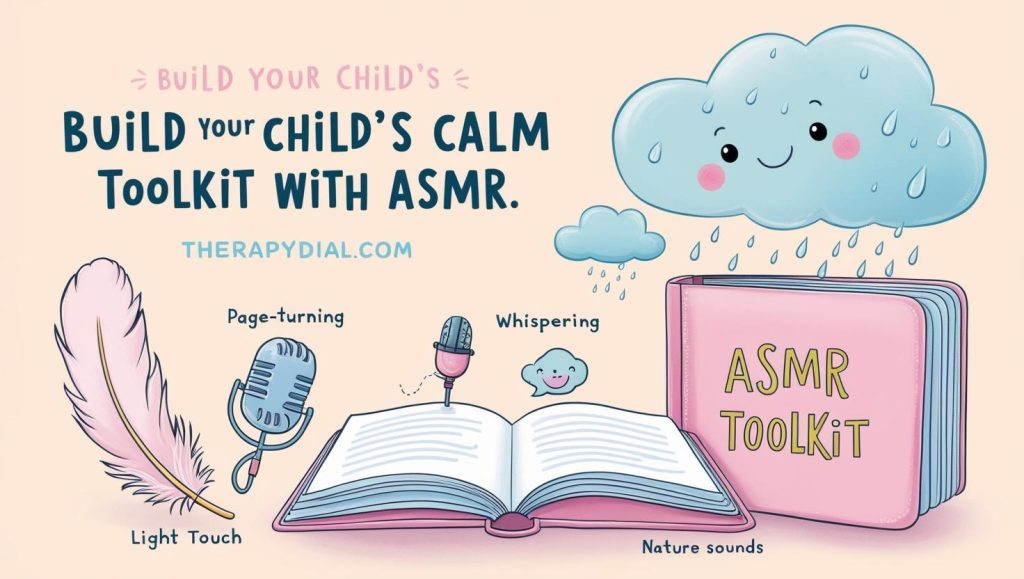
Helping Kids with Insomnia
Megan, mom of two, shared that her 8-year-old daughter struggled to sleep without melatonin. “We tried ASMR as a last resort. Now she listens to a soft brushing video every night, and she’s out within 15 minutes—no supplements needed.”
Another parent, Jordan, said their son with ADHD uses ASMR during breaks from homeschool. “It helps him reset when he’s frustrated. It’s like a soft restart button.”
Using ASMR as Part of a Bedtime Routine
Many parents now build ASMR into evening routines alongside reading or lullabies. It’s become part of a calming rhythm that eases transition into sleep. Some families even use ASMR sound machines or white noise players featuring similar textures like crackling fire, soft wind, or ocean tides.
This real-world feedback shows that when used intentionally, ASMR can become a supportive tool for both kids and parents navigating bedtime challenges.
Pediatrician and Psychologist Insights
What Experts Say About ASMR and Child Development
Medical and mental health professionals have begun recognizing the role ASMR can play in supporting children’s mental well-being. While formal pediatric guidelines around ASMR are still emerging, early opinions are largely positive—as long as it’s used appropriately.
Dr. Karen Lewis, a developmental pediatrician, explains, “ASMR doesn’t stimulate the brain in a harmful way. In fact, for many sensitive children, it provides a gentle, grounding experience that helps regulate emotional states. The key is parental supervision and moderation.”
Psychologists echo this sentiment. ASMR doesn’t alter mood in a dramatic or risky way like some overstimulating games or shows. Instead, it mimics the safe, nurturing interactions children already respond to in real life—like being read to, having their hair brushed, or hearing a parent’s calm voice.
Experts suggest ASMR may be particularly useful for children with:
- High emotional sensitivity
- ADHD or executive function difficulties
- Sleep disorders or nighttime anxiety
- Mild sensory processing challenges
When to Encourage or Limit ASMR Use
Encouragement is appropriate when:
- ASMR helps your child sleep better
- It promotes self-soothing instead of meltdowns
- Your child asks for it during moments of overwhelm
- It’s used alongside other healthy routines (reading, quiet time, etc.)
Limit usage if:
- ASMR replaces real-life interaction or conversations
- Your child becomes irritated or agitated without it
- It’s disrupting schoolwork, meals, or outdoor activity
- They’re watching content that doesn’t match their age or emotional maturity
Ultimately, ASMR is a tool—not a replacement for parental connection or emotional development. Used wisely, it’s a gentle ally in your child’s emotional toolkit.
Top Kid-Friendly ASMR Channels in 2025
Safe, Soothing, and Positive Content Creators
As ASMR continues to grow, more creators are intentionally designing content for children. These channels focus on comfort, education, and sensory calm rather than entertainment or adult-themed roleplays.
Here are some of the top-rated, parent-approved ASMR sources:
- ASMR Kids Time – Designed specifically for younger children, with soft-spoken storytelling and gentle brushing sounds.
- Wholesome ASMR – Includes “friend roleplays,” cozy sounds, and light tapping with friendly visuals.
- Calmly Creative – Educational ASMR with drawing tutorials, soft speech, and stress-relief art themes.
- Goodnight Whisperer – Sleep-focused content for children with bedtime affirmations and slow visuals.
- Soothing Stories ASMR – Gentle, parent-style reading of fairy tales, fables, and poems.
These creators avoid suggestive content and use neutral, nurturing language. They typically don’t wear excessive makeup or speak in flirtatious tones, making them more appropriate for young viewers.
YouTube, Podcasts, and ASMR Apps for Kids
Outside of YouTube, there are other child-friendly ASMR options:
- Calm App for Kids – Includes ASMR-like bedtime meditations and stories
- Moshi App – Combines storytelling, ambient sound, and mild ASMR effects
- Tingles App – Allows parental controls and filtering of family-safe content
- Spotify Podcasts – Search “ASMR for Kids” for bedtime shows and audio-only options
These platforms often have customizable timers, ad-free features, and content previews to help parents stay in control while giving kids a sense of independence.
When ASMR Might Not Be Suitable
Kids with Sensory Processing Disorders or Autism
While ASMR can benefit many children, it isn’t ideal for everyone—especially those with heightened sensory sensitivities or certain types of sensory processing disorders (SPD). For these children, the very triggers that soothe others might actually cause distress.
For example:
- Repetitive tapping might trigger irritation instead of calm
- Whispering may sound creepy or disorienting
- Slow visual hand movements can feel invasive
Parents of children with autism or SPD should observe carefully. Start with ambient sounds like rainfall or soft white noise and introduce whispering or visuals slowly, if at all.
If your child reacts negatively or avoids the content altogether, it’s okay—ASMR isn’t the only tool in the toolbox.
Avoiding Triggers That May Cause Discomfort
Every child has unique sensory preferences. What calms one may annoy another. Watch out for signs of discomfort, such as:
- Fidgeting or trying to skip parts of the video
- Covering their ears or closing their eyes
- Saying it “sounds weird” or “makes me feel funny”
Listen to their feedback and pivot to something else. Alternatives like nature sounds, soft music, or guided breathing exercises might be a better fit.
Alternatives to ASMR for Calming Kids
Meditation, Music, and Guided Imagery
If ASMR isn’t your child’s thing, there are other calming options that work similarly:
- Mindfulness apps for kids (Smiling Mind, Headspace for Kids)
- Soothing playlists with piano, harp, or ambient instrumentals
- Guided imagery with bedtime stories that paint a mental scene
- Yoga nidra sessions designed for children
Each of these tools provides structure and sensory softness—qualities kids with stress or anxiety tend to crave.
Offline Tools and Bedtime Techniques
Don’t underestimate the power of screen-free alternatives:
- Weighted blankets for pressure and comfort
- Stuffed animals with calming textures
- Night lights with rotating patterns
- Lullaby CDs or family-made bedtime recordings
- Journaling or coloring before bed
These activities support the same emotional needs ASMR addresses—connection, calm, and sensory regulation—without requiring digital access.
Final Thoughts for Parents
ASMR can be a safe, soothing, and powerful tool for children—when used wisely and intentionally. In a world filled with overstimulation and emotional chaos, kids need quiet spaces. ASMR creates one.
It’s not about chasing tingles or trends—it’s about giving your child something gentle to hold onto when the world feels too big. It might be a whisper, a soft tap, or a bedtime roleplay—but for many children, it’s exactly what they need to calm their body, slow their thoughts, and feel safe again.
So if your child’s watching ASMR, don’t panic. Join them. Ask questions. And maybe, just maybe—you’ll find some calm in it, too.
FAQs
What age is appropriate for ASMR?
ASMR can be enjoyed by children as young as 4 or 5, provided the content is age-appropriate. Parental supervision is key.
Can ASMR replace bedtime stories or music?
It can complement them, but not necessarily replace them. Try rotating ASMR with stories or soft music to keep bedtime engaging and varied.
Should I let my child use headphones with ASMR?
Over-ear headphones at low volume are safest, especially for younger children. Avoid prolonged use or in-ear buds for developing ears.
Is it okay for my child to fall asleep with ASMR playing?
Yes—just make sure to use a sleep timer or playlist that stops after a set duration to avoid all-night exposure.
Are there any ASMR apps made specifically for children?
Yes! Apps like Moshi, Calm Kids, and Smiling Mind offer ASMR-like experiences designed specifically for young audiences.
